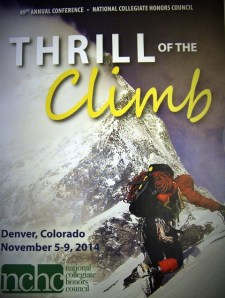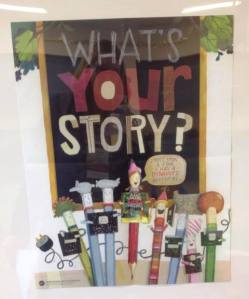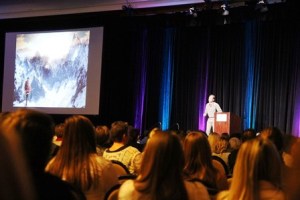 by Suzanne Unck
by Suzanne Unck
Day 5 was all about experiencing the conference. Of course Marike and I had our own presentation on honours pedagogy in The Netherlands (still excited about that experience), but there were hundreds more of them. We all went to different sessions and will share our adventures. I’ll add our experiences this week, as I receive them from colleagues and students still recovering from our trip and needing time to process this whole adventure.
At 8 am my first session on ‘recruiting and retaining gifted underachievers and unidentified gifted learners’ started. In the States high grades play an important part in recruiting for honours, but you won’t find the underachievers or students with the more non cognitive talents. I wanted to attend this session, because I sometimes encounter difficulties in identifying the rich students for honours projects. I was late… what interested me though is that the guy from Texas university said they sometimes looked for the troublemakers (often the males). “Well, they have to put that energy somewhere”. Wisconsin University sends a letter to 10.000 freshmen. The intrinsically motivated students actually apply and it leads to more diversity in their honours population.
Other interesting insights came from the audience. One university used portfolios in which they asked to submit anything they want to show accompanied by personal, but very time-consuming, interviews. The outcomes assessed with the use of rubrics, which occurred to be a measurement tool that’s being used widely in the US. Most important issues to have a high retention rate among these students is to provide an active community, have them live their passion and give them confidence that they can be creators of knowledge instead of consumers.
 Climbing Creativity: artistic and experiential assignments in honors.Christina Metcalf, Samantha Jones, Catherine Pouliot, Jordan LaBouff, University of Maine
Climbing Creativity: artistic and experiential assignments in honors.Christina Metcalf, Samantha Jones, Catherine Pouliot, Jordan LaBouff, University of Maine
In this creative roundtable session we were handed out three pins. We marked each pin with the symbol that represented ourselves. The first pin we wore ourselves, the second pin we placed on an artistic landscape representing the sky, a garden, the forest, the sea and a mountain, the third pin we had to give to someone else and ask him or her to find the art piece and stick it onto the landscape too. This was one of the exercises they did with honours students to open up an start discussing for example their different characters. Creative tasks are often perceived as frightful and challenging (by American students anyway), but they are very effective for involving a person and to stimulate critical thinking. Assessment should not concern the end product that much, but emphasize the progress made. The difficulty lies in finding the right balance between providing structure and the flow of creativity.
Tedsters and Tedheads: Partnering with TED to bring great ideas to campus.
Matthew Nickerson, Southern Utah University
In the early days theUuniversity’s honours program brought in TED talks as guest lectures. The students had to watch the TED talk of the week, write a one page paper on what it meant to them, discuss it with a guest professor, administrator or community member who commented on the TED talk. Then they had a week to conduct their own research to dive in to the matter and write a two pages paper that they were to present the next week in a mini seminar.
Next, they thought: why not have our own TED at campus with our own interested speakers? So they founded TED’s little sister PAM (Passion, Academics & Multimedia). Presentations or performances in the evening outside the classroom. Students had to film with three cameras and edit it TED style(!). This made them care less for grades, but achieving better: they simply didn’t want to suck!
Then TEDx was established by the TED organization and when they discovered PAM, there were some issues……but in the end PAM was transformed into TEDxSUU. This resulted in a lot of rules they have to comply with, but also a broadening of the audience. TED is also about the cool and funky people in the audience. So the honours students each got ten tickets to invite their coolest audience. The organization gives out 350 tickets to get to a hundred non paying visitors. SUU explored further: where do cool communities gather? They organized a TEDx in a mall after closing time.
Honours according to Matthew is about what great story to tell after graduation. By this time the whole organization of the TED event is in the hands of honours students:
learn TED – do TED – be TED
They studied the esthetics of TED, the rules to comply with, find interesting speakers, organize the location and all on a limited budget ($1200 for 90 minutes with 100 visitors). At the moment SUU has come to the same conclusion as Laurens Vreekamp, lecturer at HU Department of Communication and Journalism, presented last year on TEDxUtrecht: we should not only talk the talk, but also walk the talk. No concrete plan yet, but they are thinking about “What are we gonna do about what we talk about?”
 by Rein Kamphuis
by Rein Kamphuis
The first session I attended was about recruiting and retaining gifted underachievers and unidentified gifted learners (the same Caroline went to). It was a present- and discuss session. The point that was made was that often gifted students are not identified. Those who follow an honours program often are the high-achievers; generally students with high grades. They are successful because they do what is asked from them. They fit well in a system where knowledge is being absorbed and reproduced. But what about the real gifted; they are less docile but can be really creative and intelligent. A possible way to identify gifted students is to give them freedom in the way that they want to apply for an honours program. This could be for instance a video message, possibly about something totally different than their study. But that something that they show can reveal certain talents. So possibly the honours committee can get a good insight in their talents and intelligence.
The second session was from Iowa State University Engineering College. Again a presentation and discussion. The point that was made was that honours in an engineering college is a different kind of thing than for instance honours for a liberal arts college. The success rates were not that good. The presenters showed a method with good results so far. The method is called the Three Pillar Approach (breadth, depth and leadership). De student follows classes in each of the three pillars for a certain amount of credits. Keyword is freedom of choice. In each pillar there are many choices that can be made. The college only has one year of experience, so a comprehensive data analysis is not possible. But the first results are hopeful. In 2010 73% of the students who finished their first honours year decided to continue with the honuors program. With the new method (fall 2013 data available), this figure was 81,7%. How many students effectively complete the whole program was not shared with the audience.
The third session was about the dissonance between classroom rigor and lifelong learning/curiosity. This was a kind of a question/answer session. The presenter told that the audience would probably have more new questions than answers at the end and I agree. The presenter started with the question: ‘What is rigor’. After a while answers from the audience were inventoried. After that the presenter read out loud a definition form a certain source; one time even wikipedia. This question/answer play went on for a while. For instance the question what is lifelong learning, etc. The conclusion was that there is a certain tension between academic rigor and curiosity/lifelong learning. But answers were not given. I know, the presenter said that in advance.
 By Myrian van Koolbergen
By Myrian van Koolbergen
Bryan Ganaway, College of Charleston.
My conclusion: Interdisciplinary courses need really good preparations by developers to be succesful. Interdisciplinarity means not just bringing students from different departments together.
Giving over the reigns to the students
On November 7th, we attended the NCHC presentation “The Many Lessons of a Preceptorial” by Helene Klein (director of Honors and Accelerated Programs) and Melanie Martin (psychology major student) from Arcadia University. A preceptorial is a class that is run by the students. Handing over the reigns to the students was scary to the professor and signing up for a course with no topic was nerve-racking for the students. Students themselves needed to come up with the course topic, formulate assignments, the reading, the learning objectives, the assessment tools and decide on how to handle absentees and late assignments. The course was designated as a leadership course, so whereas the students would be focused on the class content, they would also need to be focused on lessons in leadership. The students decided on the topic “Social Deviance and Normative Behavior Through the Television Lens of Popular Culture”. The course was divided into four units, that a group of students worked on. They discussed what the research questions in their unit were, they read widely, had to take a teacher’s perspective, and learned a lot from that. One remark of Helene summarized the effects: they could not come to the class as students, they had to come as scholars.
The teacher and the student how they experienced this project presented in a very authentic and dynamic way . The teacher: “In the beginning I was afraid of losing control because I’m a control freak. But the students did a lot more than they were expected to do! They could not come to the class as students, they had to come as scholars. They overstudied their subjects, they became real experts and did their own learning. A great effect of a radical switch of the traditional teacher’s and students’ roles.” And the student: “Honours students usually want to know what they are going to learn, but in this course we could decide what, why and how we wanted to learn. This autonomy created motivation!” This presentation proves for us that giving trust and space to the students works: good results and passionate students! A real good example of honours education!
The title of the 49th NCHC honours conference here in Denver was “The thrill of the climb”. But after listening to Erik Weihenmayer’s story and feeling his engagement with life from a no-barriers mindset, the title seems besides the point. It’s not about the thrill, at least not about what that word represents in every day conversation. On the surface this statement connects to all the framed stereotypes of challenges and the reasons why people take them on. Images and ideas of adrenaline and achievement, endurance and perseverance.
Erik made it clear that however those things all come with taking life on, it is not about the thrill but about transformation. It starts with a ‘conscious decision to step into the storm, to dive into that wave’, to eventually emerge. In the way he emerged when he tumbled upside down Lava Falls in the Grand Canyon. As a blind person the only way to go down those rapids is trusting the voice of your friends when they instruct you where to go and how to move. But once in that rapid it makes no difference, a seeing person also looses all track of reality, orientation. We all get into situations like that when all our senses are confused and we have no option but to trust ourselves and more over our rope team.
Mountains are never conquered single handedly. However in the face of adversary we might think we are better off on our own, ‘linking ourselves is the best option we have’. And for that we need Trust embedded in Vision, it links the members of the rope team together. Only then can the climb begin, only then can we embark on that journey to the summit. And everybody in the rope team knows ‘the amount of adversary is directly related to the depth of the challenge, the length of the reach’. The higher we want to climb, the more we will have to face. As Erik puts it, ‘in life there are three types of people quitters, campers and climbers. What characterizes the climbers is not the ability to eliminate adversary but to deal with it.  To ‘like an alchemist change the impossible into gold’. Alchemists have the ability to use the ‘chaotic energy of uncertain environments for greatness’, not despite the adversary they encounter but because of it. ‘Adversary is the energy boast for transformation’.
To ‘like an alchemist change the impossible into gold’. Alchemists have the ability to use the ‘chaotic energy of uncertain environments for greatness’, not despite the adversary they encounter but because of it. ‘Adversary is the energy boast for transformation’.
The thrill of the climb is in that transformation. Or as Erik put it ‘a summit is the moment we realize that we have transformed our lives and those of others’. When we experience how that Vision becomes reality. When we see that ‘we can make the tools, we can build the teams, to live that no-barriers life that we envisaged.’
He encouraged us all -in honours education- to use our vision to climb that mountain and transform ourselves and those around us. In HU Honours that is precisely the path we have chosen: the adventurous journey we are on and the climb have only just begun. On this study trip we have strengthened our rope team and made it safely to the first base camp.

